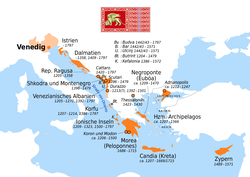Venetian Cyprus
Kingdom of Cyprus | |||||||||
|---|---|---|---|---|---|---|---|---|---|
| 1489–1571 | |||||||||
| Great coat of arms: | |||||||||
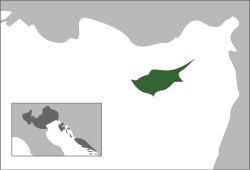 | |||||||||
| Status | Colony of the Republic of Venice | ||||||||
| Capital | Nicosia | ||||||||
| Captain General | |||||||||
• 1570–1571 | Marco Antonio Bragadin | ||||||||
| History | |||||||||
• Established | 1489 | ||||||||
• Disestablished | 1571 | ||||||||
| ISO 3166 code | CY | ||||||||
| |||||||||
| Today part of | Cyprus Northern Cyprus Akrotiri and Dhekelia | ||||||||
| History of Cyprus |
|---|
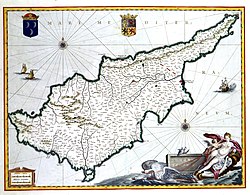 |
| |
The island of Cyprus was an overseas possession of the Republic of Venice from 1489, when the independent Kingdom of Cyprus ended, until 1571, when the island was conquered by the Ottoman Empire.
History
[edit]Acquisition
[edit]Venice for centuries wanted to control Cyprus and Venetian merchants worked on the island beginning in 1000 AD, when the Venetian (commercial and military) expansion in the eastern Mediterranean had started.
The Venetian desire for Cyprus was inspired mainly by profit. The Venetians saw Cyprus primarily as a military base. Anticipating conflict, they undertook an ambitious plan of fortification. Famagusta and Nicosia were ringed with massive earthworks, cased with stone. An outer wall was erected around Kyrenia castle, the gap being filled with earth to form an artillery rampart. The best military architects in Europe were brought in to design and execute these projects.[1]
In 1468, James II of Cyprus of the house of Lusignan became King of Cyprus. In 1468, he chose Catherine Cornaro (born in Venice from the noble family of the "Corner") as his wife and Queen consort of Cyprus. The King's choice was extremely pleasing to the Republic of Venice, as it could henceforth secure the commercial rights and other privileges of Venice in Cyprus. They married in Venice on 30 July 1468 by proxy when she was 14 years old.
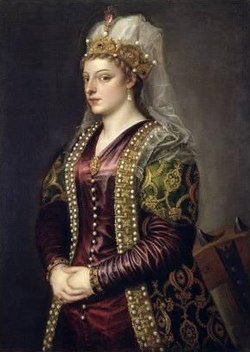
James died soon after the wedding due to a sudden illness and, according to his will, Caterina, who at the time was pregnant, acted as regent. She became monarch when their infant son James died of malaria in August 1474 before his first birthday.
The Kingdom of Cyprus had long since declined, and had been a tributary state of the Egyptian Mamluks since 1426. Under Caterina, who ruled Cyprus from 1474 to 1489, the island was controlled by Venetian merchants, and on 14 March 1489 she was forced to abdicate and sell the administration of the country to the Republic of Venice.[2]
According to George Boustronios, "On 14 February, the Queen dressed in black and accompanied by the Barons and their ladies, set off on horseback. Six knights held her horse's reins. From the moment she left Nicosia, her eyes kept streaming with tears. Upon her departure, the whole population was bewailing." So, the last Crusader state became a colony of Venice, and as compensation, Catherine was allowed to retain the title of Queen and was made the Sovereign Lady of Asolo, a county in the Venetian terraferma in northern Italy, in 1489.
The bulk of Venetian Cyprus was composed of Greek Orthodox peasants who were oppressed by the Latin ruling class (related to the former Lusignan kings), and it was estimated that there were some fifty thousand serfs. Venice favored Catholicism, which thus enjoyed a huge increase in followers: there were some problems because of this with the local Greek Orthodox priests.
Contest with the Ottoman Empire
[edit]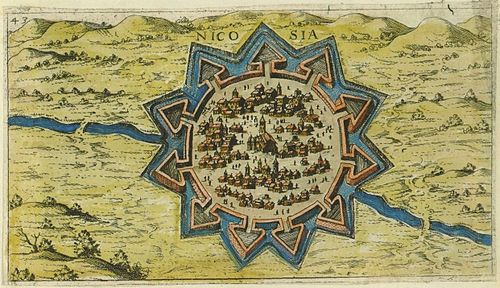
Throughout the period of Venetian rule, Ottoman Turks raided and attacked the peoples of Cyprus at will. The Greek population of Cyprus were given weapons by their Venetian rulers and fought the attacking Ottomans.
In 1489, the first year of Venetian control, Turks attacked the Karpass Peninsula, pillaging and taking captives to be sold into slavery.[3] In 1539 the Turkish fleet attacked and destroyed Limassol.[3] Fearing the ever-expanding Ottoman Empire, the Venetians had fortified Famagusta, Nicosia, and Kyrenia, but most other cities were easy prey.
In 1489, when Cyprus came under Venetian rule, Nicosia became their administrative center. The Venetian governors saw it as a necessity for all the cities of Cyprus to be fortified due to the Ottoman threat.[4] In 1567 Venetians built the new fortifications of Nicosia, which are well-preserved until today, demolishing the old walls built by the Franks as well as other important buildings of the Frankish era including the King's Palace, other private palaces and churches and monasteries of both Orthodox and Latin Christians.[5] The new walls took the shape of a star with eleven bastions: the design of the bastion was more suitable for artillery and a better control for the defenders. The walls had three gates: the "Kyrenia Gate" to the north, the "Paphos Gate" to the west, and the "Famagusta Gate" to the east.[5] The river Pedieos flowed through the Venetian walled city, but in 1567 it was diverted outside into the newly built moat for strategic reasons, due to the expected Ottoman attack.[6]
The Venetians even modified Kyrenia Castle to meet the threat that the use of gunpowder and cannons posed. The castle's royal quarters and three of its four thin and elegant Frankish towers were demolished and replaced by thickset circular towers that could better withstand cannon fire.
Indeed, commercial activity under the Republic of Venice turned Famagusta into a place where merchants and ship owners led lives of luxury. The belief that people's wealth could be measured by the churches they built inspired these merchants to have churches built in varying styles. These churches, which still exist, were the reason Famagusta came to be known as "the district of churches". The development of the town focused on the social lives of the wealthy people and was centered upon the "Lusignan palace", the Cathedral, the Square and the harbour.
In the summer of 1570, the Turks struck again, but this time with a full-scale invasion rather than a raid. About 60,000 troops, including cavalry and artillery, under the command of Lala Kara Mustafa Pasha landed unopposed near Limassol on July 2, 1570, and laid siege to Nicosia. The city fell on September 9, 1570; 20,000 Nicosians were put to death, and every church, public building, and palace was looted.[7][8] Word of the massacre spread, and a few days later Mustafa took Kyrenia without having to fire a shot. The Venetian walls of Nicosia were incomplete and not useful in stopping this powerful Ottoman army, which was reinforced in the last months of 1570.
Siege of Famagusta
[edit]
However, Famagusta, strengthened by Cyprus' governor Astorre Baglioni,[9] resisted with the Siege of Famagusta and put up a strong defense that lasted from September 1570 until August 1571.
On 15 September 1570, the Turkish cavalry appeared before the last Venetian stronghold in Cyprus, Famagusta. At this point already, overall Venetian losses (including the local population) were estimated by contemporaries at 56,000 killed or taken prisoner.[10] The Venetian defenders of Famagusta numbered about 8,500 men with 90 artillery pieces and were commanded by Marco Antonio Bragadin. They held out for 11 months against a force that came to number more than 200,000 men, with 145 guns,[11] providing the time needed by the Pope to cobble together an anti-Ottoman league from the reluctant Christian European states.[12]
The Turks lost some 52,000 men in five major assaults in early 1571, until in summer the Venetians, despairing to receive any rescue from the homeland and on request from the local starving civilians, decided to surrender. In July 1571 the Turks eventually breached the fortifications of Famagusta and their forces broke into the citadel, being repulsed only at the cost of heavy losses. With provisions and ammunition running out, his soldiers able to fight reduced to just seven hundred and no sign of relief from Venice, on August 1[13] Bragadin asked for terms of surrender. The Turkish commander, Lala Kara Mustafa Pasha, agreed to allow the survivors to safely return to Crete, but he did not keep his word: he was enraged because of his older son's death attacking so few Venetian defenders. There followed a massacre of all Christians still in the city, with Bragadin himself most brutally abused.[citation needed]
From a military point of view, the besieged garrison's perseverance required a massive effort by the Ottoman Turks, who were so heavily committed that they were unable to redeploy in time when the Holy League built up the fleet later victorious against the Muslim power at the Battle of Lepanto (1571): this was the legacy of Bragadin and his Venetians to Christianity, as Theodore Mommsen wrote. Historians[who?] to this day[when?] debate just why Venice did not send help to Bragadin from Souda, Crete. It is alleged that some Venetians thought about putting their limited military assets to better use in the forthcoming clash, already in sight, which would climax in the Battle of Lepanto.[citation needed]
The fall of Famagusta marked the beginning of the Ottoman period in Cyprus. It is noteworthy to pinpoint that this is the historical setting to Shakespeare's Othello, the play's title character being the commander of the Venetian garrison defending Cyprus against the Ottomans.
List of governors
[edit]The year given is the year of appointment.[14]
Lieutenants (luogotenenti)
[edit]- 1489 – Francesco Barbarigo
- 1491 – Girolamo Pesaro
- 1493 – Giovanni Donato
- 1495 – Andrea Barbarigo
- 1497 – Cosimo Pasqualigo
- 1500 – Andrea Venier
- 1501 – Nicola Priuli
- 1503 – Pietro Balbi
- 1505 – Cristoforo Moro
- 1507 – Lorenzo Giustiniani
- 1509 – Nicola Pesaro
- 1511 – Paolo Gradenigo
- 1514 – Donato Marcello
- 1516 – Fantino Michiel
- 1518 – Alvise d'Armer
- 1519 – Sebastiano Moro
- 1522 – Giacomo Badoer
- 1523 – Domenico Capello
- 1525 – Donato di Lezze
- 1527 – Silvestro Minio
- 1529 – Francesco Bragadino
- 1531 – Marcantonio Trevisan
- 1533 – Stefano Tiepolo
- 1535 – Giovanni Moro
- 1536 – Domenico da Mosto
- 1539 – Francesco Badoer
- 1541 – Cristoforo Capello
- 1543 – Luigi Riva
- 1545 – Carlo Capello
- 1547 – Vittorio Barbarigo
- 1548 – Salvatore Michiel
- 1550 – Alessandro Contarini
- 1551 – Francesco Capello
- 1553 – Marco Grimani
- 1555 – Giambattista Donato
- 1557 – Giovanni Renier
- 1559 – Giovanni Barbaro
- 1562 – Pietro Navagero
- 1563 – David Trevisan
- 1565 – Marino Gradenigo (died before arriving in Cyprus)
- 1565 – Pandolfo Guoro
- 1566 – Nicola Querini
- 1566 – Agostino Barbarigo
- 1567 – Nicola Dandolo
- 1569 – Sebastiano Venier
- 1570 – Daniele Barbarigo (never arrived in Cyprus)
Counsellors (consiglieri)
[edit]- 1490 – Francesco Leone
- 1492 – Bartolomeo Minio
- 1493 – Lorenzo Contarini
- 1494 – Ludovico Moro
- 1494 – Roberto Venier
- 1495 – Dona Rimondo
- 1496 – Ambrogio Contarini
- 1497 – Bartolomeo Pesaro
- 1498 – Pietro Moro
- 1500 – Nicola Pisani
- 1501 – Nicola Corner
- 1502 – Nicola Pesaro
- 1503 – Antonio Morosini
- 1504 – Girolamo Marin
- 1505 – Giacomo Badoer
- 1506 – Pietro Basadonna
- 1507 – Ludovico Contarini
- 1507 – Pietro Loredan
- 1508 – Donato di Lezze
- 1508 – Alvise d'Armer
- 1510 – Antonio Bon
- 1510 – Nicola Corner
- 1512 – Moise Leone (died before arriving in Cyprus)
- 1512 – Marino Gritti
- 1513 – Nicola Michiel
- 1514 – Giovanni Dolfin
- 1515 – Sebastiano Badoer
- 1515 – Ludovico Corner
- 1516 – Andrea Pesaro
- 1516 – Francesco Malipiero
- 1519 – Pietro Balbi
- 1521 – Sebastiano Foscarini
- 1522 – Domenico da Mosto
- 1523 – Pietro Venier
- 1524 – Marcantonio Trevisan
- 1526 – Marco Querini
- 1526 – Girolamo Marcello
- 1531 – Secondo Pesaro
- 1531 – Bernardo Venier
- 1533 – Marcantonio Calbo
- 1533 – Marco Balbi
- 1534 – Marcantonio Corner
- 1535 – Francesco Bembo
- 1536 – Sebastiano Querini
- 1537 – Marco Barbo
- 1538 – Antonio Calbo
- 1538 – Giambattista Donato
- 1540 – Michele Tron
- 1541 – Fantino Dolfin
- 1542 – Anzolo Nadal
- 1543 – Bernardo Pesaro
- 1544 – Gaspard Bembo
- 1545 – Gaspard Contarini
- 1546 – Bernardo Marcello
- 1547 – Andrea Contarini
- 1548 – Marco Pesaro
- 1549 – Maffeo Soranzo
- 1549 – Zaccaria Barbaro
- 1551 – Ludovico Ponte
- 1551 – Alessandro Zorzi
- 1553 – Girolamo Navagero
- 1554 – Antonio Zane
- 1555 – Nicola Mula
- 1556 – Ludovico Minotto
- 1557 – Giovanni Bragandino
- 1558 – Ludovico Capello
- 1558 – Lorenzo Pisani
- 1558 – Bernardo Morosini
- 1560 – Bernardino Bellegno
- 1561 – Girolamo Malipiero
- 1562 – Marco Cicogna
- 1563 – Antonio Zorzi (died before arriving in Cyprus)
- 1564 – Benedetto Contarini
- 1564 – Giacomo Ghisi
- 1565 – Nicola Loredan
- 1566 – Benedetto Mula
- 1568 – Pietro Pisani
- 1568 – Marcantonio Priuli
Notes
[edit]- ^ Whatson-Northcyprus:Venetian control of Cyprus
- ^ H. E. L. Mellersh; Neville Williams (May 1999). Chronology of world history. ABC-CLIO. p. 569. ISBN 978-1-57607-155-7. Retrieved 13 March 2011.
- ^ a b Library of Congress
- ^ "Nicosia Municipality". Nicosia.org.cy. Retrieved 10 March 2012.
- ^ a b "Nicosia Municipality". Nicosia.org.cy. Archived from the original on 6 March 2012. Retrieved 10 March 2012.
- ^ "Nicosia" (PDF). Retrieved 12 March 2013.
- ^ Turnbull, Stephen (2003). The Ottoman Empire 1326–1699 (Essential Histories Series #62). Osprey Publishing. p. 58
- ^ Hopkins, T. C. F. (2007). Confrontation at Lepanto: Christendom vs. Islam. Macmillan p.82
- ^ Astorre Baglioni biography (in Italian)
- ^ Setton (1984), p. 990
- ^ Turnbull (2003), pp. 58–59
- ^ Hopkins (2007), pp. 87–89
- ^ Madden. Page 330.
- ^ The lists are drawn from Louis de Mas Latrie, Histoire de l'île de Chypre, III, pp. 847–849.
Bibliography
[edit]- Birtachas, Stathis, Βενετική Κύπρος (1489–1571): Οι Εκθέσεις των αξιωματούχων του ανώτατου διοικητικού σχήματος της κτήσης / Venetian Cyprus: The Reports by the dominion’s supreme administrative officials, Thessaloniki: Epikentro, 2019. [bilingual edition]
- Birtachas, Stathis, Κοινωνία, πολιτισμός και διακυβέρνηση στο βενετικό Κράτος της Θάλασσας: Το παράδειγμα της Κύπρου [Society, Culture and Government in the Venetian Maritime State: The case of Cyprus], Thessaloniki: Vanias, 2011. [in Greek]
- Borowiec, Andrew (2000). Cyprus: a troubled island. Greenwood Publishing Group. ISBN 978-0-275-96533-4.
- Campolieti, Giuseppe. Caterina Cornaro: regina di Cipro, signora di Asolo Ed. Camunia. Milano, 1987.
- Diehl, Charles. La Repubblica di Venezia. Newton & Compton. Roma, 2004. ISBN 88-541-0022-6
- Foglietta, U. The Sieges of Nicosia and Famagusta. London: Waterlow, 1903.
- Romanin, Samuele. Storia documentata di Venezia, Pietro Naratovich tipografo editore. Venezia, 1853.


 French
French Deutsch
Deutsch


